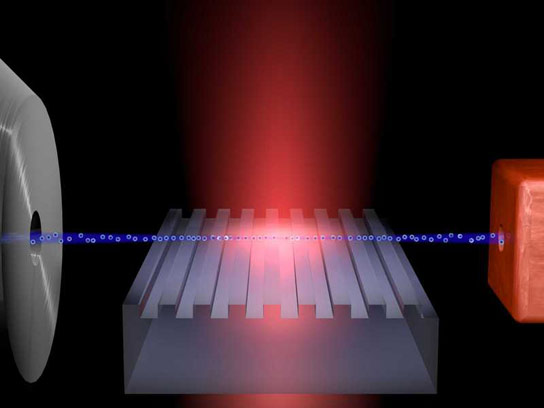
More impetus for electrons: The charged particles fly from the source (left) via an optical glass grating to a detector (right). Red laser light is beamed from below through the optical grating. Evanescent light waves, which run parallel to the surface of the grating, break away from this beam at the grating. They accelerate electrons with a stronger electric field than the electric field in microwaves, currently used for this purpose. Credit: John Breuer
Physicists at the Max Planck Institute have developed a new method that uses light to accelerate charged particles, leading the way for more compact particle accelerators.
Modern particle accelerators measure up to several kilometers in size and cost billions of euros. But thanks to a new method they could shrink to less than 10 meters and cost 10 times less in the future. To this end, physicists at the Max Planck Institute of Quantum Optics in Garching accelerated electrons directly using a light wave. In the conventional procedure, by contrast, particles are accelerated with microwaves. In their demonstration experiment, John Breuer and Peter Hommelhoff obtained an accelerating force that was equally as strong as the force achieved in current conventional particle accelerators. The unique feature of the Garching-based procedure is that it is modular and can be expanded into a multi-level system capable of accelerating charged particles – which could be protons or ions, as well as electrons – around 100 times faster than current systems, and therefore could be built to a much smaller scale. Developmental work is still necessary for this expansion, however.
Cost-effective, laboratory-scale particle accelerators measuring less than 10 meters would benefit the research community greatly. Many research groups regularly queue at the few linear accelerators in which a straight line of particles is accelerated almost to the speed of light. Smaller and less expensive accelerators, on the other hand, would be available in greater numbers and would lead to a growth in research and faster research results in areas such as nuclear physics, materials science, and life sciences.
In order to be able to build more compact particle accelerators, the electric field driving the particles would have to be strengthened. This can be illustrated by a picture in which a car represents an electron, a street stands for the electric field and the gradient of the street corresponds to the strength of the field. A stronger electric field is then equivalent to a more steeply sloping street on which a rolling car gathers the same speed on a short stretch of road than it would on a long, flatter road. But it is almost impossible to increase the electric field with current technology. Metaphorically speaking, current accelerators are an incline with a limited gradient.
The accelerating force for electrons can be increased a hundredfold using light
The limitations of modern particle accelerators are set by the material from which they are made: metal. The metal surfaces can be damaged if the electric field is too strong. The electric field strength also limits the energy that can be transferred to a particle on every meter of the path.
Non-conducting (dielectric) materials such as glass withstand electric fields that are one hundred times stronger than those found in metals, provided that light is the source of the electric field. “The accelerating force can therefore potentially be increased a hundredfold,” says John Breuer, who accelerated electrons using light as part of his doctorate at the Max Planck Institute of Quantum Optics. “Instead of being kilometers in length, accelerators would then only be 10 meters long,” he adds.
This suggests that dielectric materials should be used for the next generation of particle accelerators and that particles should be driven by light waves. John Breuer and Peter Hommelhoff, now with Friedrich Alexander University Erlangen, used glass and laser light pulses in their experiment. A team of researchers from Stanford University and the SLAC National Accelerator Laboratory in Menlo Park, California, were also working on electron acceleration at the same time, and both teams were the first to accelerate electrons using light in this way.
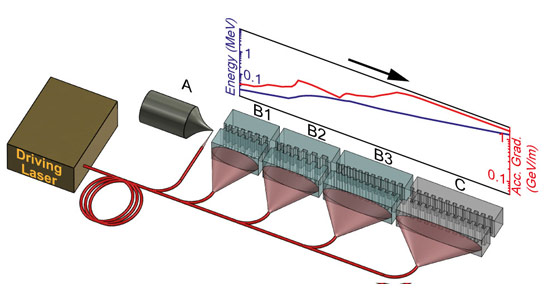
Concept study of a future accelerator: Electrons can be accelerated to the speed of light in several layers and charged with relativistic energies. The electrons from source A initially flow through sections B1 to B3, where they are not relativistically accelerated. In section C, they no longer become faster, but they gain even more energy. For the non-relativistic acceleration in sections B1 to B3, the gaps between the grooves in the grating must become bigger to facilitate continuous acceleration. A single laser delivers the energy for the acceleration. In the background, the acceleration in giga-electron volts per meter experienced by the electrons is shown in red. The blue line shows the energy of the particles at the relevant point in the channel. The image is not to scale – the grating structures are smaller than one micrometer. Credit: Physical Review Letters/John Breuer
Electrons are accelerated at the front of evanescent waves
The tiny pieces of glass used by the Garching-based researchers in their experiment have narrow grooves 750 nanometers apart, corresponding to the wavelength of red laser light. This diffraction grating, which is roughly two-hundredths of a millimeter wide, deflects perpendicularly impinging light from its straight-line direction of propagation. The beam of light is split into various fractions known as modes. Some of these modes are evanescent waves: light waves that do not spread out in the space behind the grating. Instead, they run parallel to the surface of the grating. Breuer and Hommelhoff used such an evanescent wave to accelerate electrons.
Using the electron source of a conventional electron microscope, they shot the elementary particles over the surface of the glass grating, parallel to the direction of movement of the evanescent waves. Some of the electrons experienced a similar effect to that used by surfers. The electric field active at the wave fronts accelerates the electrons in the same way that the gradient of a wave crest propels surfers. The researchers were able to measure an accelerating force of 25 mega-electron volts per meter, which corresponds roughly to the force of current accelerators.
“This shows that the principle works,” says Breuer. However, to achieve final energy suitable for applications, the glass grating must have a more complex structure. The evanescent waves therefore have to gain speed with the accelerated electrons. Their speed depends on the gap between the grooves in the glass. This gap must therefore increase along the acceleration path. The accelerating force would also increase as a result. A particle accelerator designed in this way could then be built to a significantly smaller scale than the systems built today. In this regard, Breuer emphasizes that simultaneously developed techniques, such as those in Garching and Stanford, could be combined for this purpose.
A high-performance system can be built from several gratings
Breuer cites the easy scalability of the procedure as its most important advantage. This means that an accelerator can easily be expanded into a more high-performance system by concatenating multiple gratings. Another advantage is that the accelerated electron pulses can be controlled more precisely in terms of time. As the frequency of the driving light is significantly higher than that of microwaves, shorter electron pulses with higher frequencies can also be generated, stresses Breuer. According to the physicist, this effectively results in an extremely fast electron stroboscope which allows scientists to study rapid processes, such as changes in a crystal. “The method is also suitable for the construction of future, more cost-effective, and more compact free electron lasers,” adds Breuer. Such X-ray sources are also valuable research tools in materials science and biology.
However, even the accelerators or free electron lasers that are based on the new Garching method would have their limitations. They would generate a small flow of electrons and deliver a smaller beam diameter. The associated lower power of the X-ray light compared to today’s conventional synchrotron sources can, however, be compensated for so that such innovative sources demonstrate better coherent properties – the light waves in their pulses vibrate more precisely in synchronization than the waves of standard synchrotron radiation. This would enable scientists to conduct a whole range of new experiments, ranging from high-resolution tomography to the spectroscopy of atomic nuclei.
In the future, the research team in Garching want to build structures made from dielectric materials, which are longer than the current few hundredths of a millimeter and thus facilitate greater acceleration. They also have their eye on silicon, a material that is more effective than glass for attaching more complex structures, thanks to methods established in the semiconductor industry.
Reference: “Laser-Based Acceleration of Nonrelativistic Electrons at a Dielectric Structure” by John Breuer and Peter Hommelhoff, 27 September 2013, Physical Review Letters.
DOI: 10.1103/PhysRevLett.111.134803
arXiv:1308.0464


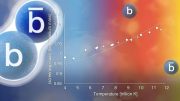




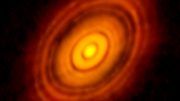
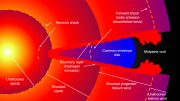
Accelerating to 25 mega electron volts is only a toy model with gratings and laser beams. We know that photons can eject electrons out of the chlorophyll of the leaves and also protons in photo synthesis.Similarly,a photo voltaic cell can generate solar power but only a toy model which cannot run the electricity for a city as the conventional ones. Once initial acceleration is done to say 25MeV conventional, Cyclotrons can be employed with their D- shaped discs to energize and drive them to acceleration near the velocity of light. Moreover the Lasers beams cannot be so strong and sturdy to excel the conventional electromagnetic beams. In all manner this happens to be only a prototype for demonstration purpose alone. Thank You.
Yeet my feet